Auctions
3 Fascinating Auction Highlights—From Basquiat to Alice Neel’s Brush with Warhol
New York's auction week kicks off with a Jean-Michel Basquiat masterwork and an intimate Alice Neel portrait of Andy Warhol's former silver Factory assistant, Gerard Malanga.
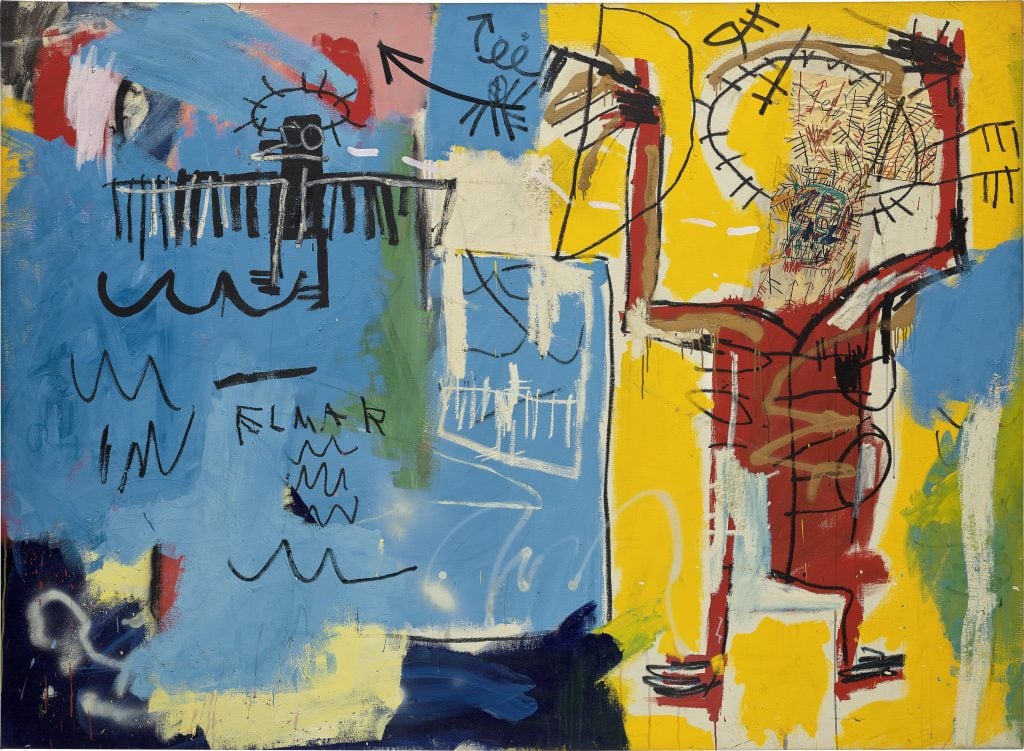
A slimmed down New York auction week kicks off today with some fascinating highlights. Among the can’t-miss offerings is an epic, monumental Jean-Michel Basquiat painting that is coming to market for the first time.
The work dates from Basquiat’s pre-Warhol period, but the Pop art pioneer’s presence crops up in other places this week, including in an evocative Alice Neel portrait of his former assistant, Gerard Malanga, as well as in one of Warhol’s own final hand-painted era of the 1960s.
Read on to learn more about the stories behind these fascinating works.
Jean-Michel Basquiat, Untitled (Elmar) (1982)
Phillips Modern & Contemporary Evening Sale
Estimate: $40 million—$60 million
The nearly 8-foot wide monumental Untitled [Elmar] is one of the most talked about works of the entire auction season—and comes to auction from the collection of Francesco Pellizzi. “We’re honored and privileged to be able to sell a painting that was acquired two years after it was made from somebody who was actually friends with Basquiat,” said Robert Manley, deputy chairman and worldwide head of Modern & Contemporary Art at Phillips. “It’s a rare opportunity,” he added, “The international interest has been overwhelming.”
The painting is rich with symbology, such as his enigmatic soaring bird motif, here adorned with a crown of thorns. But it also has a languorous sense of space, abstraction, and bold flourishes of color. It harkens back to Basquiat’s graffiti origins and also is a testament to his knowledge of art history. The work dates from 1982, a year widely seen as a benchmark peak year for the artist during his shift from street to studio art.
Basquiat had shown drawings at PS1’s New York/ New Wave in 1981; it was there that dealer Annina Nosei discovered his work and soon began representing him at her namesake Soho gallery. Pellizzi was a friend of the dealer and had helped with catalogues and acquired the paintings directly from Nosei. “He had his own sense of color,” Nosei said during a recent visit to Phillips
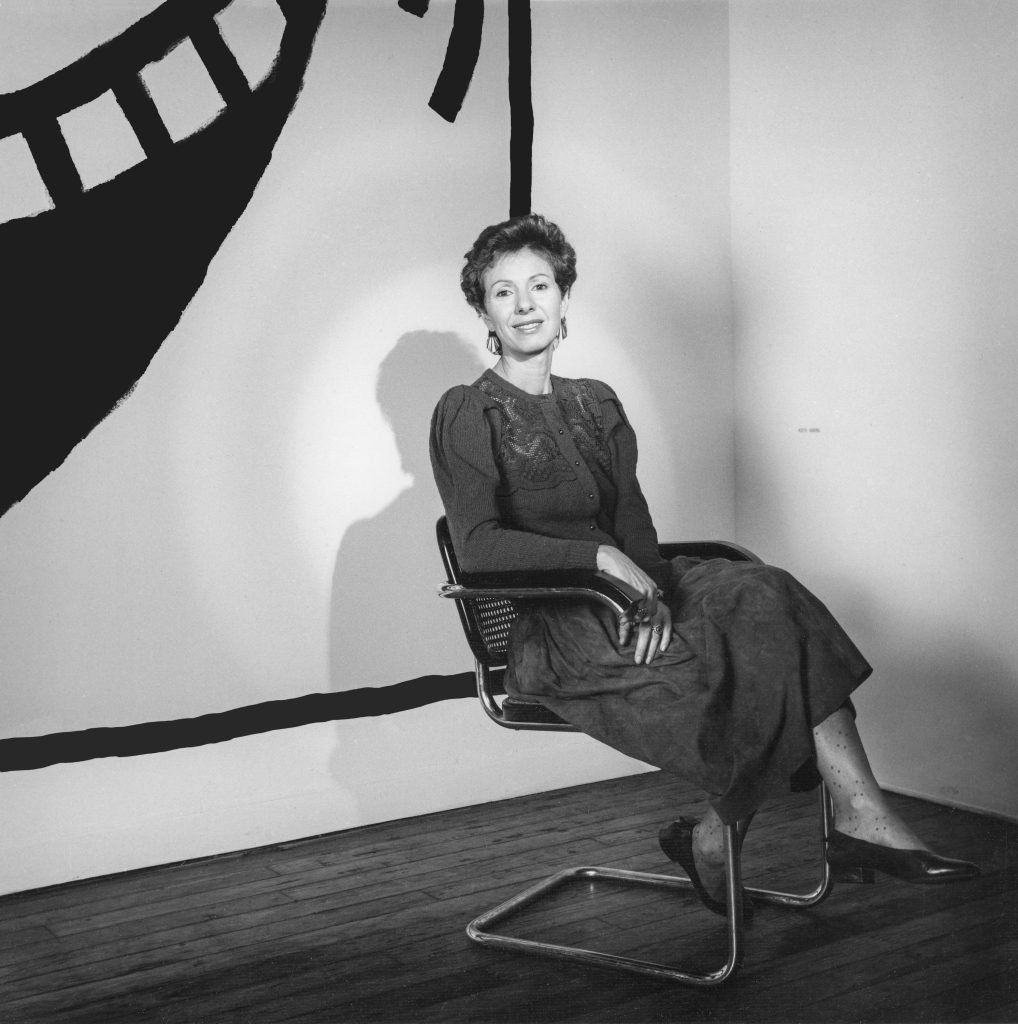
Portrait of Italian-born art dealer Annina Nosei as she poses in her gallery, New York, NY, November 3, 1982. Partially visible behind her is an unidentified Keith Haring painting. Photo: Michel Delsol/Getty Images.
Basquiat’s graffiti origins still linger Elmar, coming from a period before Basquiat’s life and work became so intertwined with Warhol’s. New York was exiting its “anti-golden age” of the late 70s and entering the 1980s boom era, with Soho became the city’s undisputed art center. The complex canvas holds within the push-pull of these tensions, including the the uptown-downtown dichotomy of the 1980s, the music scene Basquiat was involved with.
“In 1982 he’s really embracing painting,” Manley noted during a recent phone call. “Although the content and the imagery is important, what’s equally important is just creating beautiful paintings that are a little bit like Cy Twombly, Willem de Kooning to my eyes. If you compare this to other paintings in this period, you’ll see what I mean. He’s just luxuriating, and the qualities of the paint and the color and lines. In ’79 and ‘80, he’s doing graffiti on the street. By 1982, he’s really embracing becoming a more traditional artist by painting oil on canvas. But you’re still seeing some vestiges of his graffiti practice where you see some use of the spray paint, like that white line in the lower left, that’s actually spray painted. Some of the gold on the figure—that’s spray painted.”
Alice Neel, Gerard Malanga (1969)
Sotheby’s Contemporary Evening Auction
Estimate: $1.5 million–$2 million

Alice Neel, Gerard Malanga (1969). Courtesy’s of Sotheby’s.
“I feel both justified and vindicated that my 50-year quest to depict the soul and psychology of 20th-century man is being seen in this retrospective at the Whitney Museum of American Art,” Alice Neel wrote in the catalogue of her 1974 exhibition. “Today it is fashionable to be ‘cool’ and to make depersonalized images. We must trot back to human size and human feelings.”
In that same show, Neel flexed just how she was a master of depicting emotional depth by showing Andy Warhol in a brand-new light—trading Warhol’s typical wraparound sunglasses and glacial cool for vulnerability. Warhol is shown eyes shut, disfigured with battle scars and a surgical truss, the vestiges of Valerie Solanas’s infamous 1968 attack on the artist. The 1970 artwork is one of Neel’s most revelatory and recognizable paintings.
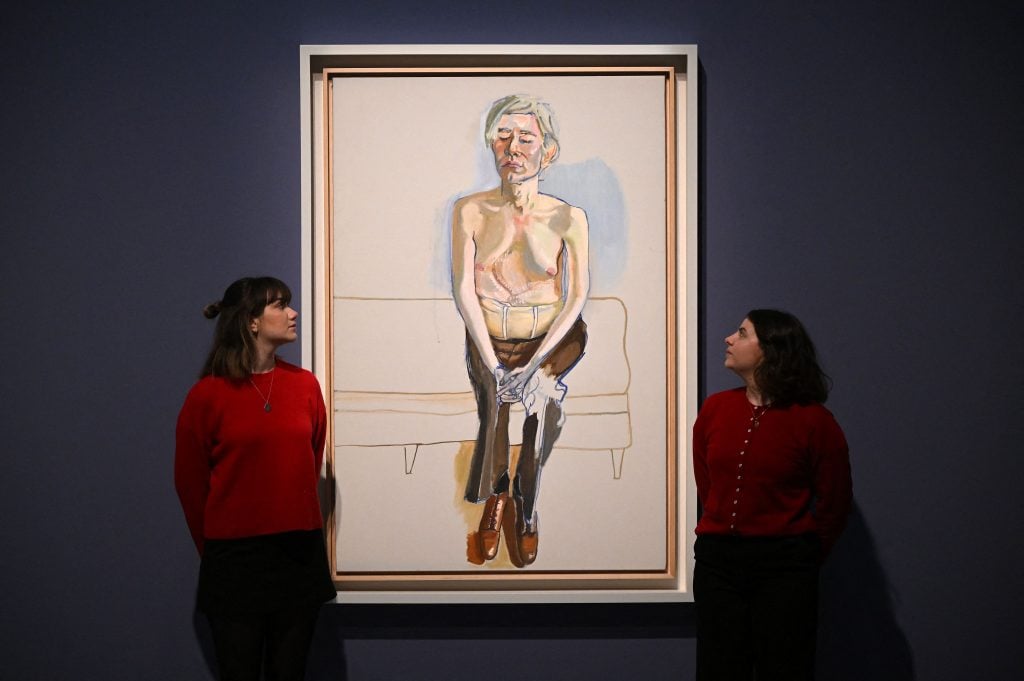
Gallery assistants pose for a photograph with Andy Warhol, 1970 during a press preview of “Alice Neel: Hot Off The Griddle” at the Barbican Art Gallery in London on February 15, 2023. Photo: Justin Tallis/AFP via Getty Images.
Neel also painted other Factory regulars. That 1974 retrospective also featured portrait Jackie Curtis and Ritta Redd (1970). The performer and playwright Curtis was the star of Warhol’s Flesh, and would later cameo in Lou Reed’s “Walk on the Wild Side. She also captured the likeness of Gerard Malanga, Warhol’s main assistant for most of the 1960s.
A dashing poet and photographer, Malanga occupied a robust variety of roles during his tenure at Andy Warhol’s Factory: silk screening assistant to the artist, bullwhip go-go dancer for the Velvet Underground’s multimedia “Exploding Plastic Inevitable” series of events, and star of such underground films as Vinyl and Chelsea Girls. He originally met Neel in 1962, and in 1969 sat for three two-hour sessions with the then 69-year-old painter. “My first reaction upon seeing it was, ‘Alice, you made me look so mischievous!’ and she said, ‘Well, that’s the way I saw you when I was painting you!’” Malanga said in a visit with Sotheby’s earlier in the week.
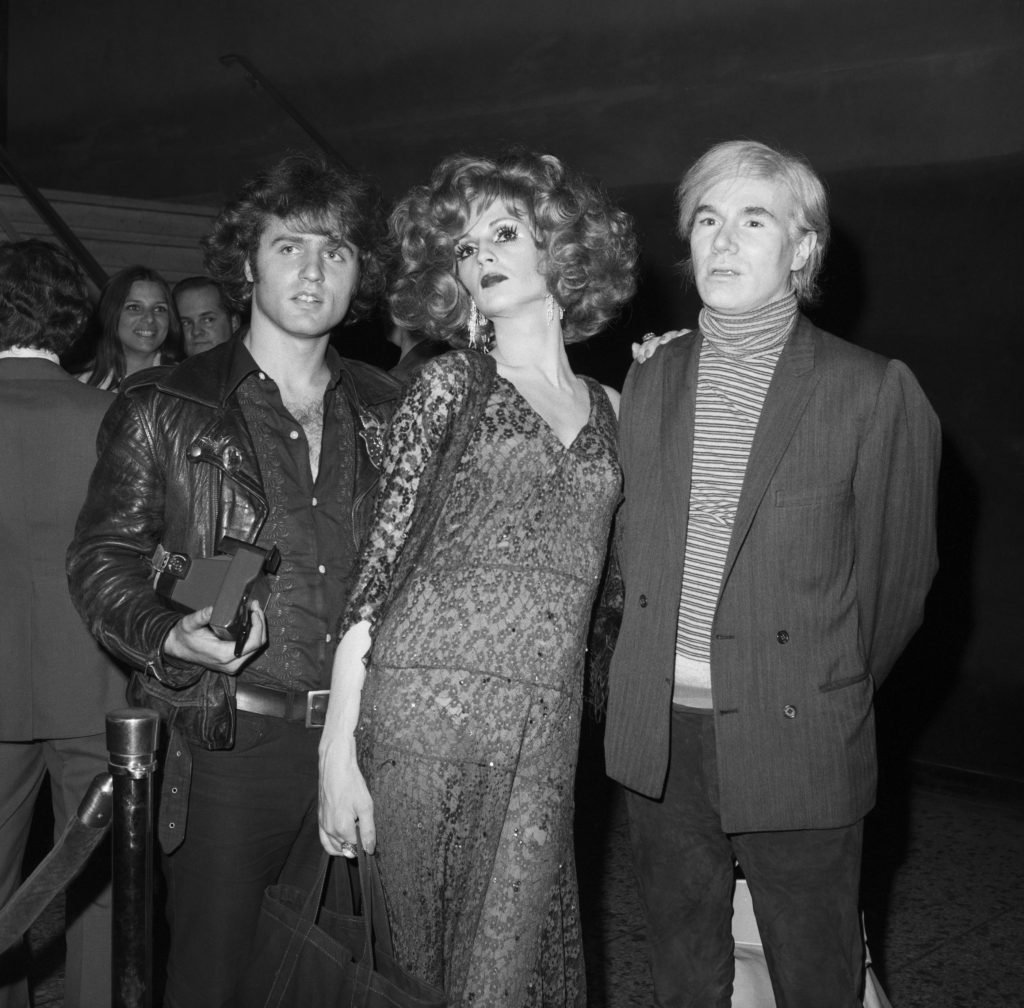
Pop artist Andy Warhol is accompanied by two of his superstars, Candy Darling and Gerard Malanga, as they arrive at a Manhattan theater for the premiere of Midnight Cowboy on May 5, 1969.
He told the Guardian, “Alice was a very funny lady. We got on very well. I used to shop for her, get food for her. We had a good little time. She was very meticulous about expressing herself on canvas. Painting allowed her a freedom of imagination. She’s as much a part of the painting as I was. It’s a collaboration in essence.”
Last year on Instagram Malanga wrote, “Alice’s portraits are like a solid vintage wine. We age well with time. The only one missing is Alice. What a kind and heart-loving soul she was. My lucky stars she ever wanted to paint me!”
Andy Warhol, Carat (1961)
Sotheby’s Contemporary Evening Auction
Estimate: $5 million–$7 million
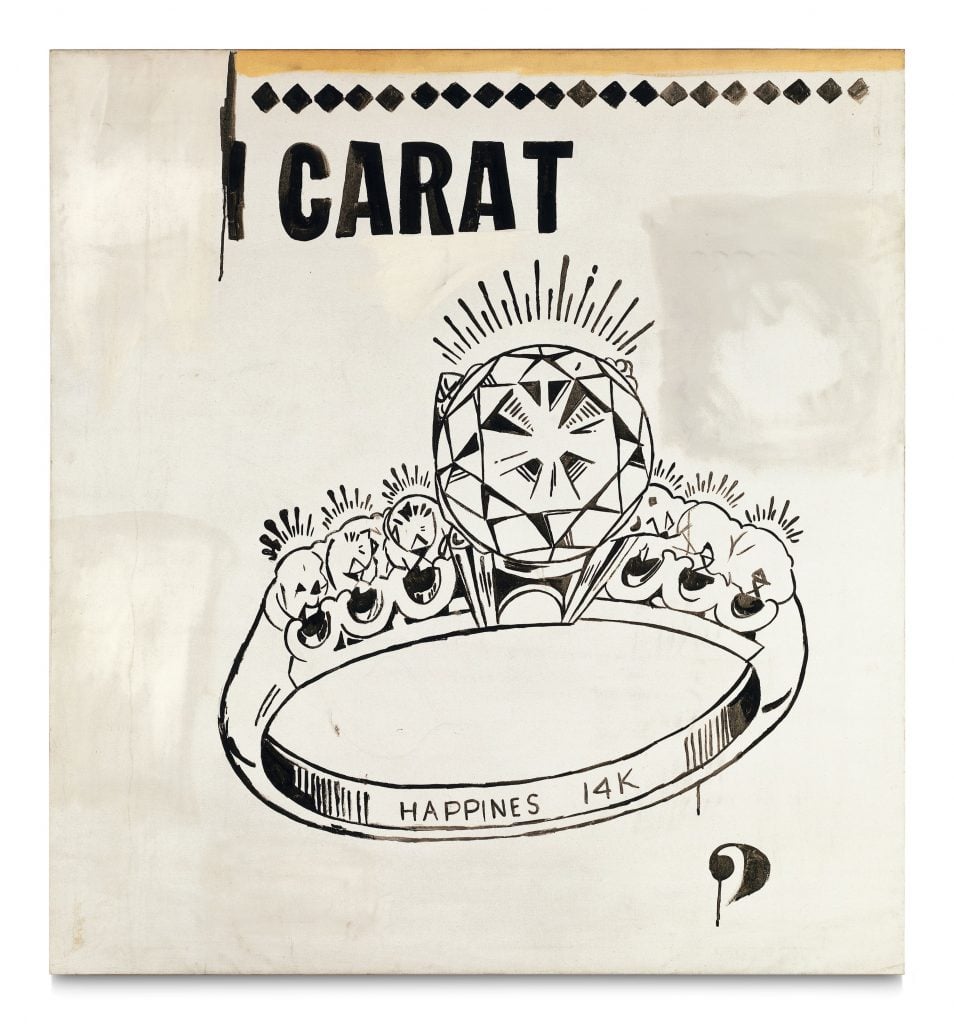
Andy Warhol, Carat (1961). Courtesy of Sotheby’s.
Speaking of Warhol, a wonderful depiction of transitional bling by the artist is up for auction tonight as well. Carat was previously in the collections of his former business manager Fred Hughes and Swiss dealer Thomas Ammann.

Busch jewelry ad from New York Daily News (July 1, 1959)
Besides the inner-circle provenance, the work includes the drip and drabs of Warhol’s hand-painted works from the beginning of his fine art era (before he switched over primarily to silk-screen). The early work bears many attributes that would become Warhol hallmarks– allusion to mass consumption and production and a fascination with imagery from newspaper—the latter of which would factor in one of his most famous series, “Death and Disaster” a few years hence. (Tunafish Disaster is also on offer and is a killer—literally—lot).





